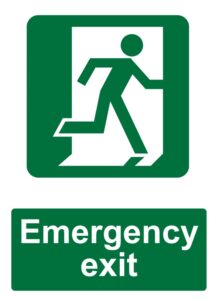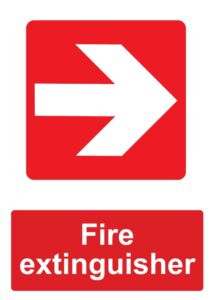Beginners Guide To Health And Safety Signage

There are a lot of different health and safety signs you might come across on a daily basis, but some are more common than others as they’re needed in every workplace. While customers or visitors to the business aren’t expected to know what every health and safety sign means, some are made to be obvious so that in an emergency, people know what to do.
For a business owner, putting up health and safety signs at work is part of your responsibilities. We’re going to explain the most common health and safety signs, the different colours and what they mean, plus why you need health and safety signage and where it should be.
In this article:
The Most Common Health And Safety Signs
What Are Health And Safety Signs?
The Different Types Of Health And Safety Signage
Prohibition Signs
Mandatory Signs
Warning Signs
Safe Conditions Signs
Fire Safety Signs
Who Needs Health And Safety Signage?
Where Should Health And Safety Signage Be Placed?
The Most Common Health And Safety Signs
From gyms to schools, warehouses to restaurants, here’s some of the most common health and safety signage you might see:
1. Emergency Exit Signs
Emergency exit signs are the green and white signs above doors and routes that provide a clear means of escape during an emergency. Their shape and colour make them easy to spot, so everyone knows where to go should an incident occur. This might take people through fire doors and reinforced corridors that are designed to keep fires at bay while people evacuate.
2. Fire Equipment Signs
Fire equipment signs will normally be found close to fire action signs, but not exclusively. Wherever there’s fire fighting equipment, such as blankets or extinguishers, an accompanying sign will inform you what equipment is nearby and brief instructions on when it should be used, such as what type of extinguisher it is and what fires it can be used on. The equipment itself will have more instructions.
3. No Smoking Signs
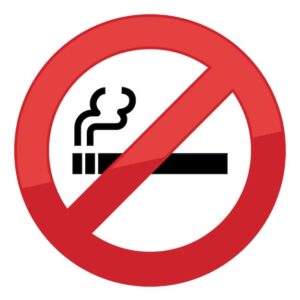
No smoking signs are used to indicate areas that, by law, must be smoke-free environments. This covers indoor areas and areas near entrances, vents and high traffic areas where the smoke could affect passersby. Appropriate disposal bins need to be nearby too, so that no ashes or remains can catch fire and spread to other areas of the business.
4. Slippery Surface Signs
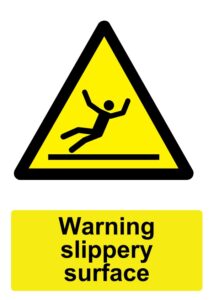
Slippery surface signs are used when a spillage has occurred. They are used to let people know a hazard is in the area, and once clean, to identify that the floor could still be slippier than usual. This gives people the information they need to take care of themselves, and because these incidents can occur anywhere, the signs are often mobile. They can be placed in the centre of or around an area.
5. Fire Action Signs
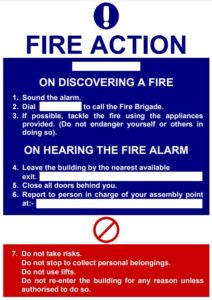
Fire action signs will be displayed in every business to make sure that in the event of a fire, staff, customers and visitors know what to do. This sign is actually a combination of colours, as it includes prohibition sections, mandatory sections and safe conditions sections. The colours match their types of sign and convey clear instructions should a fire be found.
What Are Health And Safety Signs?
Health and safety signs are a visual way to display important information regarding health precautions and safety regulations. You will likely see health and safety signs in most places you visit, including workplaces, public areas, and construction sites. The Health And Safety Executive (HSE) advises employers that health and safety signs must be used if there is a significant risk that can’t be avoided or controlled in any other way.
Health and safety signage is designed to promote awareness and prevent accidents or injuries by providing clear and easily understandable messages. Signs are an essential element of workplace health and safety, guiding individuals to make informed decisions and ensuring a safer environment for everyone.
The Different Types Of Health And Safety Signage
There are five main types of health and safety signage, and each is characterised with a colour. The different colours you’ll see on health and safety signs are red, blue, yellow and green. The corresponding colour signals a specific action, and while the sign itself will have further details about that action, the colour makes the intent easy to understand at a glance. This system is all part of keeping people safe in as many situations as possible, making it simple to know what action you should – or shouldn’t – take when you see a health and safety sign. The five signs are:
- Prohibition Signs – ‘Do Not’
- Mandatory Signs – ‘You Must’
- Warning Signs – ‘Be Aware’
- Safe Condition Signs – ‘Follow Me’
- Fire Equipment Signs – ‘Here It Is’
We’ll go into each sign and the corresponding colour in more detail below.
1. Prohibition Signs
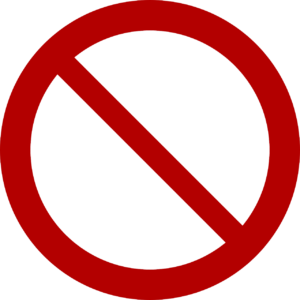
Prohibition signs are probably the most obvious health and safety signs you’ll see. They highlight actions that should not be taken in a given area. These are coloured red and are usually circular symbols with black pictograms on a white background for added emphasis. There will be a warning with them to highlight further what the action is that is being prohibited.
Examples of these signs include:
- No entry
- No smoking
- No parking
- No running
These signs are designed to protect people from accidents or injuries that the specified actions might cause. Smoking, for example, is not only a health hazard for people nearby, but represents a fire risk. The sign mitigates the risk of both outcomes from a single action.
2. Mandatory Signs
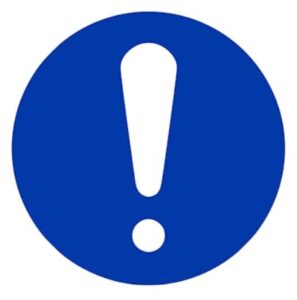
Mandatory signs are predominantly blue and tend to be circular. They are used to instruct people of an action they must follow or complete in a certain area. The pictogram is white on the blue background, and text usually accompanies the image for clarity.
Examples include:
- Wear a face covering
- Keep clear
- Pedestrians only
- Keep fire door closed
In some situations, people need to be reminded to do something or follow instructions to stay safe. Implementing these health and safety signs at work helps people to be more aware of everything they need to know; for example, engineers in a manufacturing plant who need to wear PPE in certain areas and for specific tasks.
3. Warning Signs
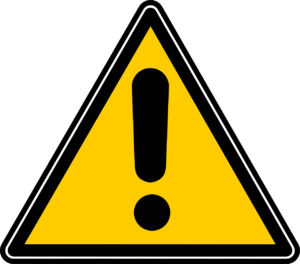
Warning signs are used when people need to be aware of a risk, danger or hazard. These signs are triangular in shape and predominantly yellow. The text and pictogram are both black, making people aware of the situation, so they can take steps to protect themselves from accidents. The nature of the warning will change depending on the environment.
Some examples of warning signs are:
- Slippery floor
- High voltage
- Mind the step
- Hot water
Warning health and safety signage is used when people are capable of taking care of themselves, as long as they are aware that there’s a hazard present. Every effort should be made to minimise the hazard before the sign is put up, but an extra warning adds another level of safety. Wet floor signs are a good example of this. Spillages should be cleaned, but even light moisture can make the surface slippery for a time after, and this warning sign would make people aware of that.
4. Safe Condition Signs
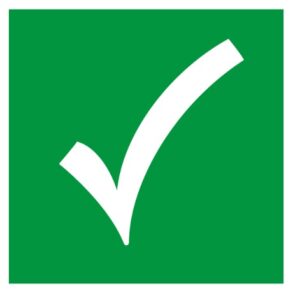
Safe condition signs are green with white pictograms and text, and usually rectangular in shape, although some may be square. They represent directions to safety in an emergency, or supplies to keep people safe – such as a first aid kit – as well as areas with no danger.
Examples of safe condition signs include:
- Emergency exit
- First aid kit
- Emergency stop
- Assembly point
Safe condition signs are about ensuring people are safe in every situation. This is most commonly seen with emergency exit signs in any building. In an emergency, people need to know exactly where to go, and if the fire marshal is not on hand to help, these signs convey those directions. They can even be placed in front of light units for areas with poor lighting.
5. Fire Safety Signs
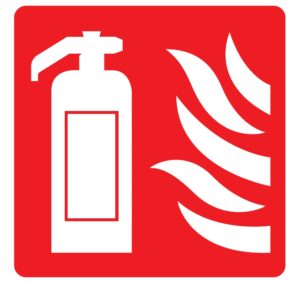
Fire safety signs are used to direct people towards fire safety equipment and indicate the correct actions to take during a fire emergency. They are also red, like prohibition signs, but are generally a different shape, most often rectangular.
Examples of fire safety signs include:
- Identifying fire escape routes
- Indicating where fire extinguishers are
- Showing directions to assembly points
Fire safety signs are an integral component of a fire risk assessment, ensuring that people can respond quickly and safely in case of a fire.
Who Needs Health And Safety Signage?
Every business needs to have relevant health and safety signs in the workplace. Employers must ensure that adequate health and safety signage is in place to keep employees and visitors safe. Some industries may need more health and safety signs than others. An office, for example, has fewer hazards than a construction site. There will likely be some variation in the types of signs used according to the environment, such as healthcare settings with a large number of chemical hazards needing different signage than a retail store with customers to manage. Essentially, all workplaces must have health and safety signs by law, but the number and the type will differ.
Where Should Health And Safety Signage Be Placed?
Wherever there is a risk or hazard people need to be aware of, the correct health and safety sign should be used – and placed close to the area of the hazard. This is to ensure everyone who may be affected can be made aware of the situation and act accordingly.
Safe condition signs should be placed wherever people need to follow a direction to remain safe – such as with emergency exits. Every route that is a designated emergency route should be marked with a clear sign. Mandatory signs also need to be present whenever people must do something in an area, such as wearing protective equipment.
In short, these signs should be as close as possible to whatever they’re protecting people from, warning them about, or instructing them to do.
Learn More About Health And Safety Signage
There’s a huge range of health and safety signs out there, but not all apply to every business or industry. Part of what we do at Rhino Safety is to make sure you have the right signs up, so that staff, customers and visitors to your business know what to do in any situation.
This follows a thorough health and safety audit and understanding of your business. We identify where the signage should be placed for maximum effect and ensure you have the resources and knowledge to make sure every member of staff knows what to do in the face of hazards and risks.
To find out more about how we can help with health and safety signage in your business, contact our team at Rhino safety today.

